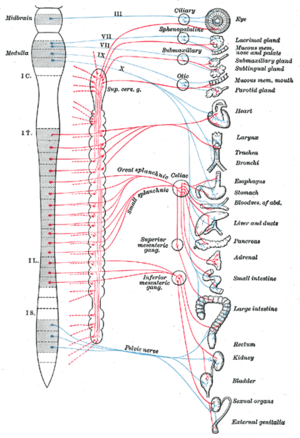General structure of the autonomic nervous system
The autonomic nervous system (ANS) includes neurons of the central and peripheral nerves. The name autonomic nervous system indicates the independence of its functions from the central nervous system (ANS works reflexively, it is not controlled by our will). The activity of the system affects basic life functions associated with food intake, circulation, metabolism and functions associated with maintaining life. The ANS is referred to as the autonomic nervous system (especially in older literature).
Function[edit | edit source]
The function of the ANS is the regulation of the internal environment of the organism, ensuring the proper functioning and activities of internal organs, innervation of smooth muscles , heart , blood vessels and glands. Autonomic neuropathy ( cardiovascular autonomic neuropathy , gastrointestinal, etc.) can cause disorders of the ANS function.
Arrangement in a chain sensitive neuron — interneuron — motor neuron.
The structures that make up the ANS are located firstly in specialized formations - ganglia, truncus sympatheticus and autonomous nerve networks of internal organs, then in the CNS in the brain and spinal cord, where there are efferent neurons, and also in the peripheral NS in organs and tissues.
The efferent neuron does not communicate with the target organ or tissue directly, but through at least one interneuron.
Construction[edit | edit source]
The mother cells of the autonomic ( vegetative ) nervous system are located in the cell clusters of the ganglia of the brain and spinal cord. ANS nerves are made up of at least two neurons. Nerves make up the visceromotor systems, which begin in the CNS . Unlike somatomotor nerves, they do not travel directly from the CNS, but are connected to other neurons in the ganglia along the way. Therefore, there are so-called preganglionic neurons that go to the ganglion and postganglionic neurons that go from the ganglion to another neuron or to the innervated tissue.
Division[edit | edit source]
We divide the autonomic nervous system into two functional groups:
- sympathetic (pars sympathica) – fight or flight
- parasympathetic (pars parasymphatica) – rest and digest
- ENS – enteric nervous system – rather a separate system
The pars sympathica has nuclei in the CNS that form the nucleus intermediolateralis on the sides of the spine in the range of segments C 8 – L 3 (therefore we refer to the sympathetic as the thoracolumbar system ).
Pars parasymphatica has nuclei in the CNS near the cranial nerves (the so-called cranial parasympathetic ) and in the nucleus intermediolateralis on the sides of the spine in the range of segments S 2 - S 4 (the so-called sacral parasympathetic ). That's why we refer to the parasympathetic system as the craniosacral system .
In addition to the sympathetic and parasympathetic, there is another, third component of the ANS – the enteric (intramural) system . The enteric system consists of nerve plexuses and small ganglia in the organ wall of the alimentary canal, approximately from the cardia of the stomach to the upper border of the internal sphincter of the anus. It controls the muscle tension ( tone ) and movements of the walls of the alimentary canal and the secretory activity of their bile. After the interruption of sympathetic and parasympathetic fibers, most of the functions of the enteric system are preserved. This is due to the fact that only a small part of the neurons of the enteric system is directly innervated by sympathetic and parasympathetic fibers.
Difference between sympathetic and parasympathetic[edit | edit source]
Sympathetic and parasympathetic act antagonistically (oppositely) on most organs. E.g. the sympathetic increases heart output, the parasympathetic decreases it. The sympathetic increases body temperature, the parasympathetic lowers it. On the contrary, the parasympathetic increases the secretion of the glands and the movement of the digestive tube, and the sympathetic, in turn, has a dampening effect.
The basic neurotransmitter of the sympathetic and parasympathetic preganglionic neurons is acetylcholine , the postganglionic sympathetic neurotransmitter is noradrenaline , and the parasympathetic postganglionic neurotransmitter is acetylcholine.
Links[edit | edit source]
References[edit | edit source]
ČIHÁK, Radomír – GRIM, Miloš. Anatomie 3. 2., upr. a dopl edition. Grada, 2004. 673 pp. ISBN 80-247-1132-X.
UŠÁKOVÁ, Katarína. Biológia pre gymnáziá 6. 3. edition. 2010. ISBN 9788080912178.
PETROVICKÝ, Pavel. Klinická neuroanatomie CNS s aplikovanou neurologií a neurochirurgií. 1. edition. Triton, 2008. ISBN 978-80-7387-039-3.



